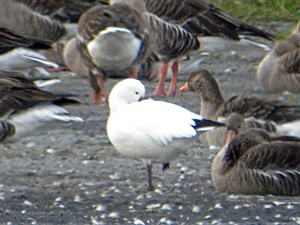The Black Swan was with a herd of 38 Mute Swans feeding in the field across the river and upstream of the railway bridge. Several hundred Grey-lag and Canada Geese were also there. The Willow Tit was briefly heard and seen along the Lower Path, five Cetti’s Warblers were heard as well as four Water Rails. PS.
Tag Archives: Grey-lag Goose
Willow Tit – 22nd November
This morning there were several hundred mainly Grey-lag Geese on the Large Gravel Pit. Amongst them was the Mandarin drake again and the Black Swan is still in residence. A young male Peregrine was hunting over the reserve and a Golden Plover flew over calling. Along the Lower Path there were some small finch flocks and a flock containing several Redpoll also had a Willow Tit tagging along. Four geese flying over separately from the other geese were possibly White-fronted Geese, but it wasn’t possible to get a good view of them to be certain. PS.
Bittern – 10th November
An estimated 6,000 Starlings came in to roost this evening, at one stage about 5,000 were displaying together before dropping in to the reed bed and the rest came in in small and larger groups afterwards. A Bittern flew across the Slurry Lagoon and joined the Starlings, perhaps fancying a Starling supper. Up to three Sparrowhawks were also trying to snatch a Starling from the flocks, none successfully. Later a few Canada Geese and about 1,000 Grey-lag Geese came in to roost on the Slurry Lagoon. PS.
Mandarin – 19th October
This evening, whilst watching about 5,000 Starlings come in to roost, a strange looking duck came in with a squadron of Grey-lag Geese. It stayed with the flock as they flew over and was still with them when they returned to land on the Slurry Lagoon. Looking through a scope it was clear to see it was a drake Mandarin. There were also three Snipe and up to five Water Rail, one showing quite well by the bench. Earlier a 1st winter Bearded Tit was also seen in the reed bed. PS.
Later on the Black Swan came in to roost in the Deep Pit. RW.
Raven – 24th November
This afternoon a Raven paid a brief visit to the lagoons, flying over the Deep Pit before doing a u-turn and flying back the way it had come. The Starling roost contained about 4,500 birds this evening and a Water Rail dashed across the gap in front of the seat. Over 1,000 geese came in to roost on the Slurry Lagoon as it got dark. They were mainly Grey-lag with Canadas, and there was one Barnacle Goose with them. PS.
Marsh Harrier – 24th October
This afternoon a ‘cream-top’ Marsh Harrier was seen briefly over the Slurry Lagoon reed bed. It was chased off by some crows and a gull. The sweetcorn has been harvested in the adjacent fields and the geese are gleening the spillage. About 2,500 Grey-lag Geese and 500 Canadas flew from the fields onto the Slurry Lagoon. Later up to 6,000 Starlings came in to roost, in their spectacular fashion, in the Slurry Lagoon reed bed. PS.
White-fronted Goose – 21st November
As the light faded this evening the Grey-lag and Canada Geese started to arrive to roost on the Large Gravel Pit and Slurry Lagoon. When it was almost dark the White-fronted Geese were heard and about twenty-four birds were picked out against the dim sky as they came in to roost on the large Gravel Pit. As I walked off a female Tawny Owl was heard and, a little later, some Golden Plover were heard as they flew in. PS.
Mediterranean Gull – 3rd November
The gull roost contained a first winter Mediterranean Gull and an adult Yellow-legged Gull this afternoon. Several Water Rails were heard or seen across the site, as were hunting Sparrowhawks. One Sparrowhawk was seen to fly into the Starling roost causing them to move across the Slurry Lagoon to another reed bed. As the light failed a massive flock of Grey-lag Geese rose unseen from the harvested maize field, where they had been feeding, to move to the Large Gravel Pit, to roost. The noise they made cackling and screeching was very impressive. RW, PS.
Starling – 31st October
As the light dimmed, at about 16.15, the Starlings began to arrive to roost. A group of about 1,000 formed and did an aerial display, then decided to have a mass bathe amongst the gull roost. Another group of about 1,000 arrived and then both groups amalgamated and smoked into the reed bed. Then lots of smaller groups of fifty to 200 birds arrived, mostly from the east and dived spectacularly into the reed beds to join the others. This carried on for about thirty minutes until I estimated about 4,500 birds were in the roost. Whilst this was happening there were echelons of Grey-lag and Canada Geese arriving to roost on the Large Gravel Pit and the numbers grew to about 1,200 Grey-lag and about 800 Canadas. On the Slurry Lagoon the gull roost reached in excess of 1,000 birds but the light did not make counting them practical. A Water Rail flew across the gap in the reed beds in front of the bench and the Cetti’s was in good voice. PS.
